Advertisements
Advertisements
प्रश्न
Why are aryl halides less reactive towards nucleophilic substitution reactions than alkyl halides? How can we enhance the reactivity of aryl halides?
उत्तर
Aryl halides are less reactive towards nucleophilic substitution reaction due to the following reasons.
(i) In haloarenes, the lone pair of electron on halogen are in resonance with benzene ring. So, C – Cl bond acquires partial double bond character which strengthen C – Cl bond and difficult to be substituted by nucleophile.
Therefore, they are less reactive towards nucleophilic substitution reaction.
(ii) In haloarenes, the carbon atom attached to halogen is sp2 hybridised. The sp2 hybridised carbon is more electronegative than sp3 hybridised carbon. This sp2-hybridised carbon in haloarenes can hold the electron pair of \[\ce{C - X}\] bond more tightly and make this \[\ce{C - Cl}\] bond shorter than \[\ce{C Cl}\] bond of haloalkanes.
Since, it is difficult to break a shorter bond than a longer bond, therefore, halorenes are less reactive than haloalkanes.
(iii) In haloarenesm the phenyl cation is not stabilised by resonance therefore SN1 mechanism cannot be followed.
(iv) Because of the repulsion between the nucleophile and electron-rich arenas, aryl halides are less reactive than alkyl halides.
How to increase reactivity
The reactivity of aryl halides can be increased by the presence of an electron withdrawing group (-NO2) at ortho and para positions. No effect is observed by the presence of electron withdrawing group at weta-position Mechanism of the reaction is as depicted with OH ion:
The presence of NO2 groups at ortho and para positions withdraws electrons density from the benzene ring and therefore, facilitates the attack of the nucleophile on haloarenes. The carbanion, thus formed is stabilized through resonance as shown below:
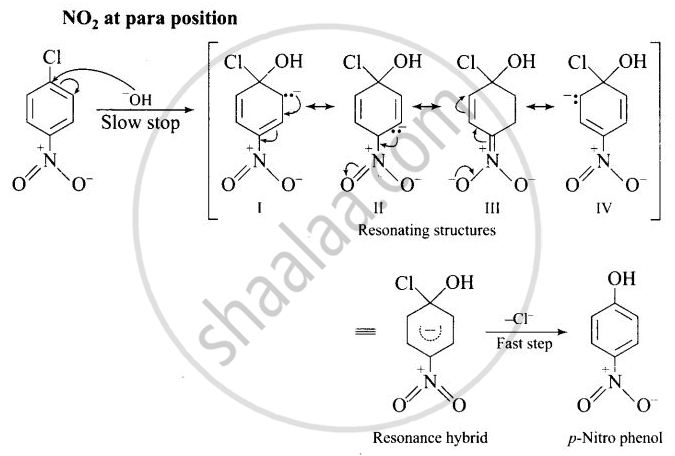
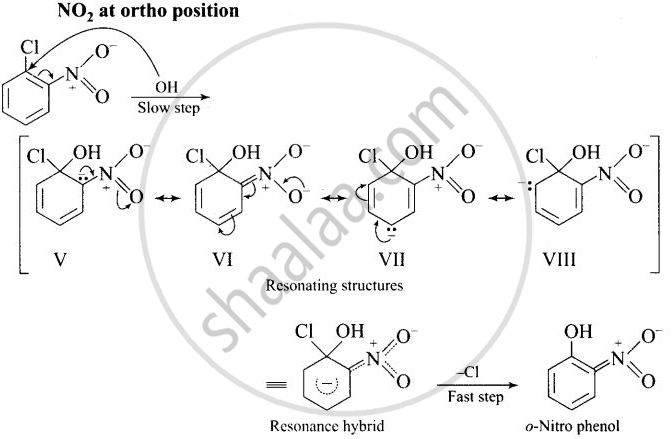
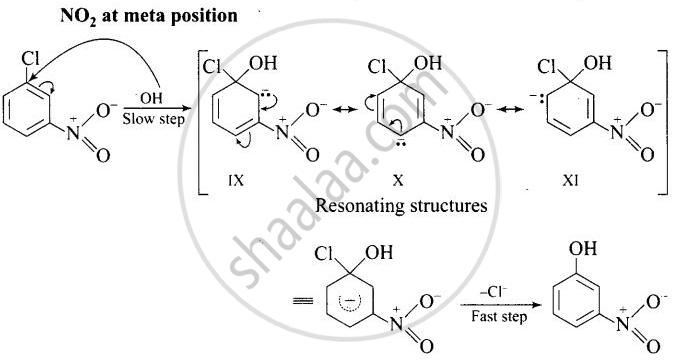
It is clear from above structure that in case of o- and p-chlorobenzenes, on the resonating structures (II in case of p-nitro chlorobenzene and V in case of o-chlorobenzene) bear a negative charge on the carbon atom bearing the \[\ce{NO2}\] group.
Therefore, these carbanions are stabilized by the -NO2 groups as well as π-electrons of the benzene ring. However, in case of m-nitrochlorobenzene, none of the resonating structures bear the negative charge on carbon atom bearing the -NO2 group. Therefore, the nitro group at meta position does not stabilize the negative charge but the carbanion is stabilized only by the p-electrons of the benzene ring. In other words, the carbanions formed from o-nitrochlorobenzene and p-nitrochlorobenzene are most stable than that formed from m-nitrochlorobenzcne.
Thus, the presence of electron withdrawing groups at o- and p-positions (but not at m-positions) w.r.t. halogen atom activates the aryl halides towards nucleophilic substitution reaction.
APPEARS IN
संबंधित प्रश्न
Discuss the mechanism of alkaline hydrolysis of bromomethane.
Most reactive halide towards SN1 reaction is ____________.
Tertiary alkyl halides are practically inert to substitution by SN2 mechanism because of ____________.
Which of the following compounds is optically active?
Racemic compound has ____________.
Assertion: KCN reacts with methyl chloride to give methyl isocyanide.
Reason: CN– is an ambident nucleophile.
Read the passage given below and answer the following question:
Nucleophilic substitution reaction of haloalkane can be conducted according to both SN1 and SN2 mechanisms. However, which mechanism it is based on is related to such factors as the structure of haloalkane, and properties of leaving group, nucleophilic reagent and solvent.
Influences of halogen: No matter which mechanism the nucleophilic substitution reaction is based on, the leaving group always leave the central carbon atom with electron pair. This is just the opposite of the situation that nucleophilic reagent attacks the central carbon atom with electron pair. Therefore, the weaker the alkalinity of leaving group is, the more stable the anion formed is and it will be more easier for the leaving group to leave the central carbon atom; that is to say, the reactant is more easier to be substituted. The alkalinity order of halogen ion is I− < Br− < Cl− < F− and the order of their leaving tendency should be I− > Br− > Cl− > F−. Therefore, in four halides with the same alkyl and different halogens, the order of substitution reaction rate is RI > RBr > RCl > RF. In addition, if the leaving group is very easy to leave, many carbocation intermediates are generated in the reaction and the reaction is based on SN1 mechanism. If the leaving group is not easy to leave, the reaction is based on SN2 a mechanism.
Influences of solvent polarity: In SN1 reaction, the polarity of the system increases from the reactant to the transition state, because polar solvent has a greater stabilizing effect on the transition state than the reactant, thereby reduce activation energy and accelerate the reaction. In SN2 reaction, the polarity of the system generally does not change from the reactant to the transition state and only charge dispersion occurs. At this time, polar solvent has a great stabilizing effect on Nu than the transition state, thereby increasing activation energy and slow down the reaction rate. For example, the decomposition rate (SN1) of tertiary chlorobutane in 25℃ water (dielectric constant 79) is 300000 times faster than in ethanol (dielectric constant 24). The reaction rate (SN2) of 2-bromopropane and NaOH in ethanol containing 40% water is twice slower than in absolute ethanol. In a word, the level of solvent polarity has influence on both SN1 and SN2 reactions, but with different results. Generally speaking, weak polar solvent is favorable for SN2 reaction, while strong polar solvent is favorable for SN1 reaction, because only under the action of polar solvent can halogenated hydrocarbon dissociate into carbocation and halogen ion and solvents with a strong polarity is favorable for solvation of carbocation, increasing its stability. Generally speaking, the substitution reaction of tertiary haloalkane is based on SN1 mechanism in solvents with a strong polarity (for example, ethanol containing water).
Nucleophilic substitution will be fastest in case of ______.
How do polar solvents help in the first step in SN1 mechanism?
Match the reactions given in Column I with the types of reactions given in Column II.
| Column I | Column II | |
| (i) | 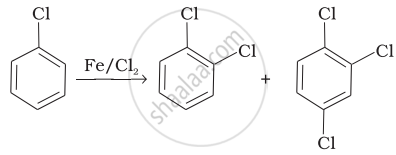 |
(a) Nucleophilic aromatic substitution |
| (ii) | \[\begin{array}{cc} \ce{CH3 - CH = CH2 + HBr -> CH3 - CH - CH3}\\ \phantom{............................}|\phantom{}\\ \phantom{.............................}\ce{Br}\phantom{} \end{array}\] |
(b) Electrophilic aromatic substitution |
| (iii) | 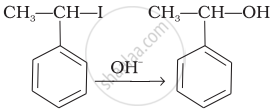 |
(c) Saytzeff elimination |
| (iv) | 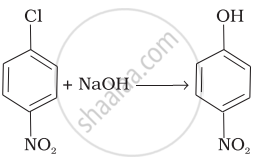 |
(d) Electrophilic addition |
| (v) | \[\begin{array}{cc} \ce{CH3 CH2 CH CH3 ->[alc.KOH] CH3 CH = CH CH3}\\ \phantom{}|\phantom{..........................}\\ \phantom{}\ce{Br}\phantom{........................} \end{array}\] |
(e) Nucleophilic substitution (SN1) |
Give reason for the following:
The product formed during SN1 reaction is a racemic mixture.
